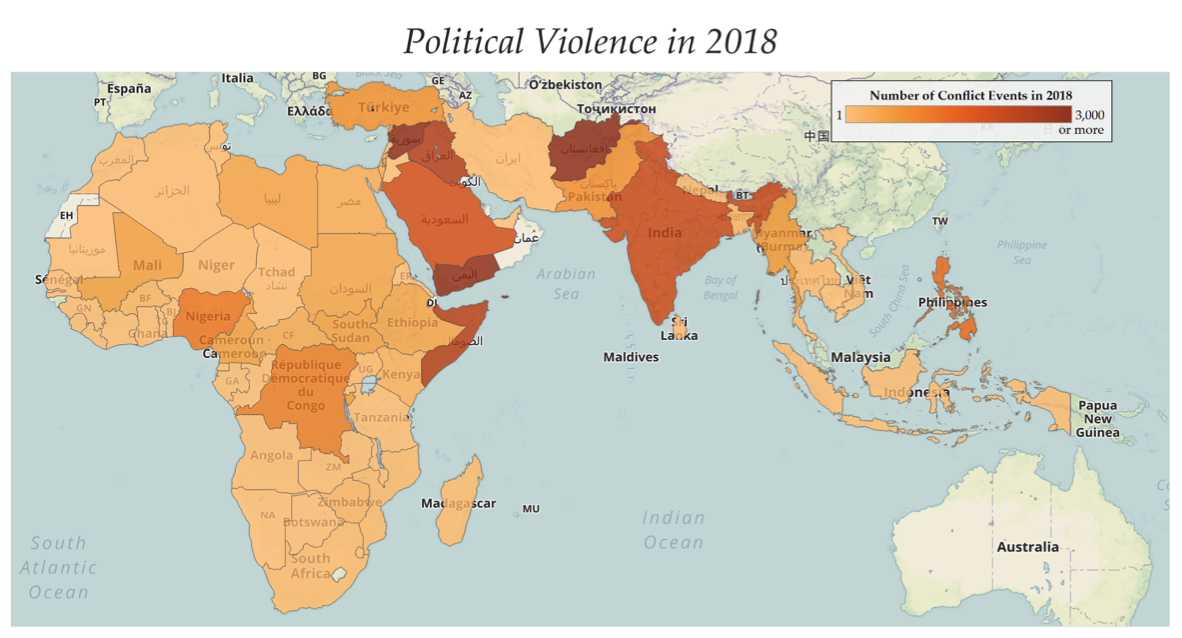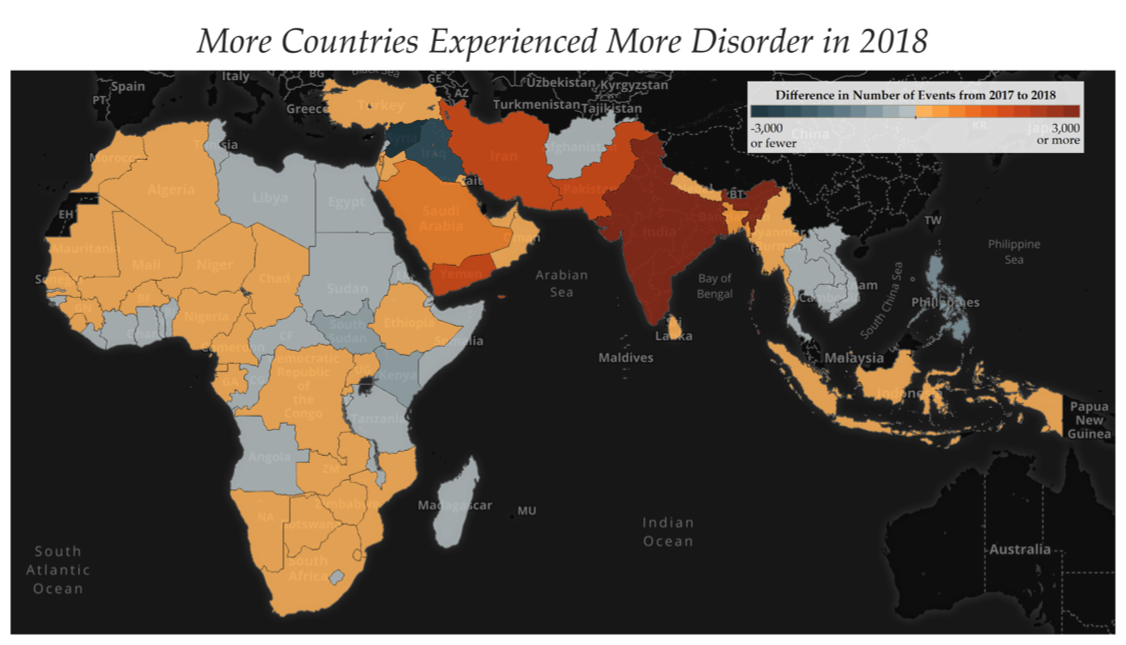21 December 2018: Despite a decrease in total fatalities this year, the majority of countries experienced more conflict, expanding the scope of political violence across Africa, Asia, and the Middle East. The Armed Conflict Location & Event Data Project (ACLED)’s 2018 data show that both the number of new locations experiencing violence and the number of armed actors engaging in violence have risen since 2017. ACLED data also confirm that conflict hotspots like Afghanistan, Yemen, and Syria still have the highest rates of organized violence and highest death tolls, with a combined total of nearly 100,000 reported fatalities this year.
Commenting, ACLED Research Director Roudabeh Kishi: “Looking at where event counts and reported fatalities are highest can help to identify conflict hotspots. But, relying on these aggregate figures alone misses the whole picture of what happened in 2018. While political violence decreased overall in volume, it also expanded. In 2018, more locations saw violence, more conflict actors emerged, more actors targeted civilians than before, and more countries saw disorder increase than decrease within their borders. Overall, the footprint of conflict expanded significantly.”
Top Trends:
- Political violence is spreading: The number of locations in which conflict occurred increased by 11% worldwide
- Conflict actors continue to proliferate: There was a substantial increase in the number of actors participating in conflict events across the areas of ACLED coverage, with a 16% increase in the number of distinct actors active from 2017 to 2018
- Despite the growing prevalence of non-state actors, state actors remain the most violent actors worldwide: State actors in Yemen, Syria, and Afghanistan were active in the highest number of conflict events in 2018
- Conventional warfare dominates: The most violent countries in the ACLED dataset in 2018 are those with large conventional conflicts: Syria, Yemen, Afghanistan, and Iraq. Together, these four countries make up nearly 70% of all organized violence events recorded by ACLED in 2018
Regional Hotspots:
- The war in Afghanistan is the most lethal conflict in the world: Afghanistan was by far the deadliest country covered by ACLED in 2018, with nearly as many fatalities as Syria and Yemen combined, and 30% of all fatalities reported by ACLED during the year at more than 41,000*
- Syria and Yemen remain flashpoints: The conflicts in these two countries had the highest number of organized political violence events in 2018 and were also the most dangerous places for civilians. Syria alone made up nearly 40% of the total number of violence events recorded for 2018, while this was the deadliest year for Yemen since ACLED began monitoring the war in 2016, with over 28,100 fatalities
- Syria is the deadliest place for civilians: In 2018, nearly as many civilians were killed in Syria (over 7,100) as were in Nigeria, Yemen, Afghanistan, and the Philippines combined (over 7,600 total) – the next four countries topping the list of deadliest countries for civilians*
- The Philippines is a war zone in disguise: Over 1,000 civilians were killed in the Philippines in 2018 – more than in Iraq, Somalia, or the DRC – highlighting the lethality of Duterte’s state terror campaign dubbed the ‘War on Drugs’
This analysis is drawn from ACLED’s forthcoming report, Year in Review: 2018, by ACLED Research Director Roudabeh Kishi and Research Analyst Melissa Pavlik. It will be issued along with our annual data release in January 2019.
A US-based 501c3 established in 2014, ACLED is the highest quality, most widely used, realtime data and analysis source on political violence and protest around the world. ACLED is the only data project providing publicly accessible realtime coverage of trends in 2018 that allows users to conduct analysis across a range of different measures and manifestations of disorder. Data are free to download here.
If you would like to use ACLED analysis or visuals, please review our Terms of Use and Attribution Policy.
For interview requests and press inquiries, please contact:
Sam Jones, Communications Officer
[email protected]
___________
Download a PDF of this press release here.
___________
*Note: “Fatality numbers are frequently the most biased and poorly reported component of conflict data. They are often debated and can vary widely. Conflict actors may overstate or underreport fatalities to appear strong to the opposition or to minimize international backlash against the state involved. And the numbers can be off simply because it’s difficult to collect exact data mid-conflict. While ACLED codes the most conservative reports of fatality counts to minimize over-counting, this does not account for biases that exist around fatality counts at-large.” In the case of Afghanistan, fatality counts are even more unreliable given the nature of reporting, and so may be overcounted here, even despite ACLED’s conservative fatality estimating. The unreliability of fatality estimates at large, and in the Afghan case in particular, cannot be overstated.
ACLED’s fatality estimates only include deaths directly caused by violence. Civilian fatality estimates only include civilians killed as a result of direct civilian targeting; it does not include collateral civilian fatalities. As such, the number is assumed to represent an underestimate of total conflict-related civilian fatalities.
Find more information about ACLED’s methodology for coding fatalities here; our specific methodology for collecting data on the Yemen conflict here; for Afghanistan, here; and for the Philippines, here.







